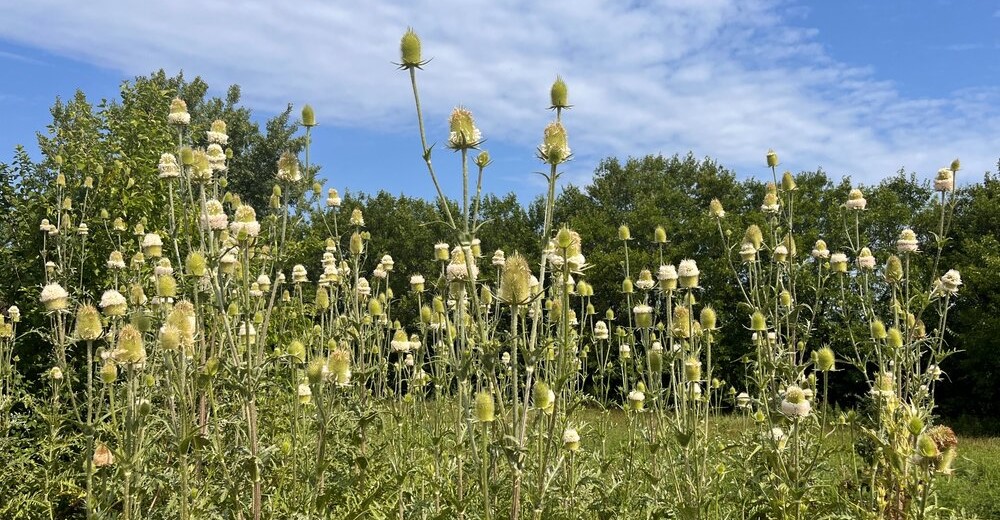Teasel: An invasive species coming to a roadside near you?

JACKSONVILLE, Ill. — If you’ve driven along any interstates or highways in Illinois, there’s a good chance you’ve seen tall plants with spiky flower heads. Teasels have become an increasingly common site across Illinois. While they may appear attractive, especially for cut flower arrangements, these troublesome plants can form large colonies that outcompete and choke out native plants.
What does teasel look like?
There are two species of teasel commonly found in Illinois, cutleaf teasel (Dipsacus laciniatus) and common teasel (Dipsacus fullonum). Teasel grows as a basal rosette, the leaves appear puckered with scalloped edges, for at least a year. During this time, they will develop a large taproot, which can be over two feet long and an inch in diameter.
Once plants have acquired enough energy, they will produce large flower stalks that can be 7+ feet tall and prickly. The plants will also produce large prickly leaves along the stems.
While they only flower once, each plant can produce multiple flower heads. Cutleaf teasel usually has white flowers and will bloom from July through September, while common teasel typically produces purple flowers and blooms from June to October. The flowers are small and clumped in dense oval-shaped, spiky heads. After seeds are produced, the stems will turn brown and may remain standing throughout winter.
How did teasel get here?
Teasel is native to Europe, Asia and North Africa. It was introduced to North America in the 1700s for use in the textile trade. For hundreds of years, seed heads have been used to raise the nap of cloth (teasing). The teasing process brings loose fibers to the surface and makes the cloth feel softer.
Dried seedheads are also used in flower arrangements. They are also widely used in craft projects. It is important to note that teasel is listed as an invasive plant in Illinois through the Illinois Exotic Weed Act, meaning it cannot be bought, sold, or distributed in Illinois.
The problem(s) with teasel
Teasels are aggressive plants, with cutleaf being more aggressive than common, that can rapidly spread and outcompete native plant species. The thousands of seeds each plant is capable of producing can remain viable for at least two years. This can lead to dense patches of plants that make it difficult for other species to survive.
While seeds typically don’t disperse very far, seeds along highways can be spread by passing vehicles or mowing equipment. Seeds can also be spread by birds and water.
In addition to their prolific seed production, teasels have no natural enemies in Illinois. Very little eats them, allowing them to quickly spread once they are established in an area.
Managing teasel
- The rosette stage can be dug from the ground. Smaller rosettes are easier to remove, because large rosettes will have developed a large tap root.
- Once plants begin to flower, the flower heads can be cut and bagged, and the roots can be chopped 1 to 2 inches below the soil surface. Make sure to remove and dispose of the flower heads; seeds will continue to develop even after the flower heads have been cut off.
- Unfortunately, mowing teasel is not an effective way to manage it, plants will still produce flowers, even after repeated mowing.
- Herbicides containing glyphosate or triclopyr can be applied to plants in the rosette stage in the spring or early summer. Once the plants begin to produce flower stalks (bolt), herbicides become less effective. If you use herbicides, make sure to read and follow all label directions.
Good Growing Fact of the Week: The size of the rosette is a better indication of when a teasel plant will flower than the age. Teasel rosettes usually do not produce a flowering stem until they are at least 12 inches in diameter.
Miss Clipping Out Stories to Save for Later?
Click the Purchase Story button below to order a print of this story. We will print it for you on matte photo paper to keep forever.

